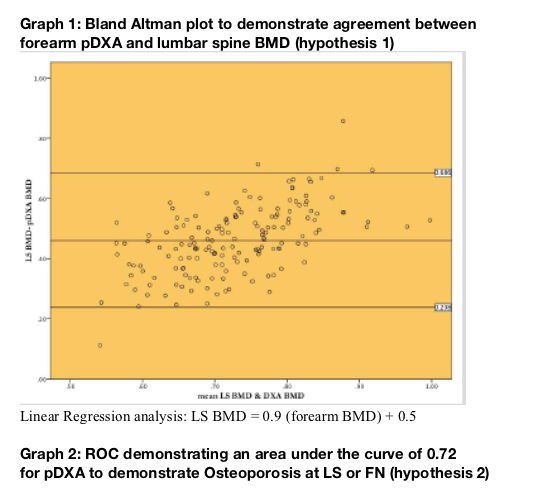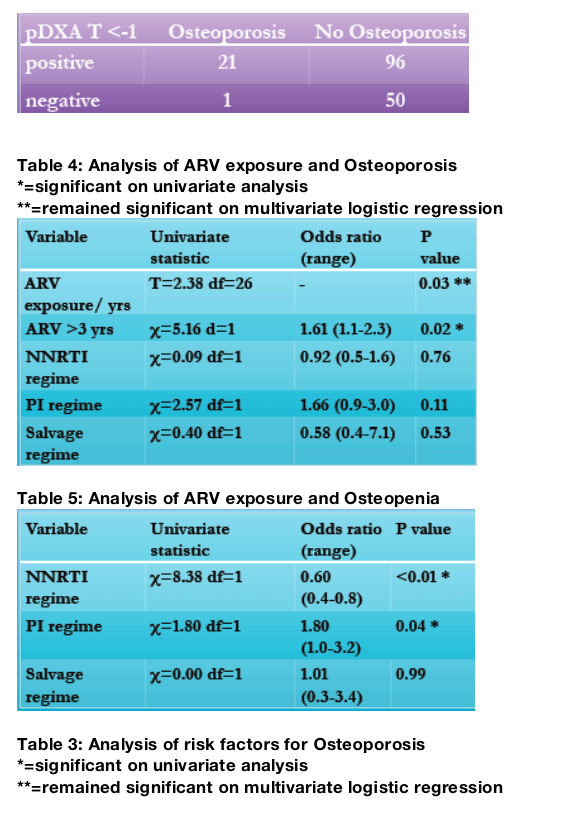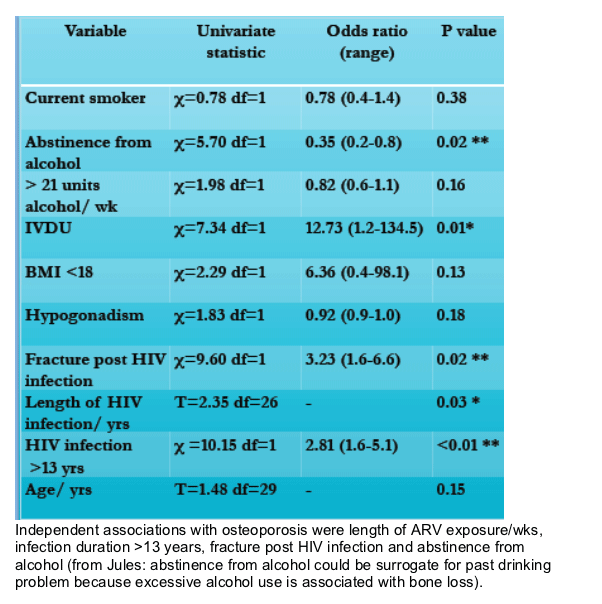 |
 |
 |
| |
Evaluation of peripheral DEXA Bone Densitometry to identify low bone mineral density in HIV- infected men in UK: 60% osteopenia, 13% osteoporosis- median age 41 yrs; t-score/dexa predicts fracture in HIV
|
| |
| |
Reported by ules Levin
CROI 2009 Feb 8-12 Montreal
CE Short1, S Shaw1, M Fisher1, K Walker-Bone2 and Y Gilleece1
1 Brighton and Sussex University Hospital Trust, Brighton, East Sussex, UK; 2 Brighton and Sussex Medical School, Brighton, East Sussex, UK
Funding: This study was awarded the British HIV Association Research Award 2007. The GE Lunar PIXI pDXA
was donated by the Alliance for Better Bone Health, Procter and Gamble.
Author Conclusions
This is the first study to demonstrate fracture sustained after HIV infection is
independently associated with a T score <-2.5 (OR 3.23 (1.6-6.6) p=0.02), indicating the known natural history of osteoporosis applies in the context of HIV infection.
The pDXA has a high discriminatory power as a screening tool (95% sensitivity and 98% NPV) when compared with gold standard axial DEXA.
Osteopenia was identified in 60 % of subjects and Osteoporosis in 13% demonstrating the burden of disease in an aging population. Length of ARV exposure was independently associated with osteoporosis, supporting recently published data4.
pDXA is safe, acceptable, well tolerated and portable. It is easily used in routine clinical practice to identify those patients who need DEXA imaging. pDXA will form part of a continuous screening program at this centre, enabling long term cost benefit analysis.
Abstract
Introduction: We evaluate the role of peripheral DEXA (pDXA) as a screening tool for osteoporosis in an HIV positive male population.
Methods: A prospective study of 168 HIV infected males. Subjects underwent screening of the non dominant forearm with pDXA and standard central DEXA imaging of the lumbar spine (LS) and femoral neck (FN). A receiver operator characteristic curve (ROC) established the threshold T score that produces optimum values of sensitivity and specificity for pDXA to identify osteoporosis.
Methods: Subjects were recruited from a cohort of HIV+ men attending a single HIV center during a 4-month period (May to August 2008). Consecutive attendees were recruited to the 3 following categories: group A, ARV naïve; group B, receiving ARV <3 years; group C, receiving ARV >3 years. Subjects underwent a forearm pDXA and DEXA imaging of the lumbar spine and femoral neck within 12 weeks. Data on risk factors for low bone mineral density were collected. WHO (World Health Organization) T score classification was used to calculate values of sensitivity and specificity for pDXA to identify osteoporosis at any site. Multivariate logistic regression was used to evaluate independent risk factors for low bone mineral density.
Results:
We recruited 149 men: group A-n = 31, median age 41 years (range 20 to 54), median duration ARV 0 weeks; group B-n = 38, median age 45 years (range 26 to 58), median duration ARV 55 weeks (range 1 to 145); group C-n = 80, median age 46 years (range 27 to 85), median duration ARV 522 weeks (range 158 to 959).
Osteopenia at any site (LS/FN) by DEXA was found in 100/168 (60%). Osteoporosis at any site was found in 22/168 (13%). ARV exposure/ yrs (p=0.03), HIV Infection >13 yrs (p=0.03), abstinence from alcohol (p=0.02) and fracture post diagnosis (p=0.02) were independently associated with osteoporosis at any site. Using a threshold of T<-1, pDXA has 95% sensitivity and 35% specificity to identify osteoporosis at any site, with a negative predictive value of 98%.
Conclusion: This is the first study to demonstrate low BMD in HIV-infected men is independently associated with fracture post HIV diagnosis. pDXA has a high discriminatory power as a screening tool and could be easily used in clinical practice
Background
Osteopenia and osteoporosis are increasingly recognized in HIV and may cause significant long-term morbidity1,2.
Randomised control trials have demonstrated that bisphosphonate therapy can significantly improve bone mineral density (BMD) in this population3.
The standard for measuring BMD -Dual Energy X-ray Absorptiometry (DEXA) of the lumbar spine (LS) and femoral neck (FN), is impractical for use as a routine screening tool.
We evaluate the use of peripheral forearm DEXA (pDXA) to screen a cohort of males with HIV-infection for low BMD.
Analysis
Statistics
· Agreement of pDXA forearm BMD values against BMD values of the forearm, LS and FN obtained by standard DEXA using Bland Altman Plots.
· Linear regression to describe the relationship between forearm BMD and LS/FN BMD.
· Receiver Operator Characteristic Curve (ROC) to establish the T score that generates the optimum sensitivity and specificity for pDXA to detect Osteoporosis at the LS/FN.
· Independent T tests, Chi squared, Odds ratios and multivariate logistic regression were undertaken to evaluate independent risk factors risk factors for low mineral density with HIV.
· The study was designed to generate 90% power to detect an area under the ROC (AUC) greater than 0.5 assuming that the true AUC is 0.7 (hypothesis 2).
Hypotheses
1. The agreement between the non dominant forearm BMD and lumbar spine or femoral neck BMD and their mean will lie between 2 SD of 0 (95%CI)
2. The area under the ROC curve (AUC) for sensitivity vs false positive rate will be >0.7 for the diagnosis of osteoporosis using pDXA
3. A threshold T score that produces a sensitivity and specificity of >90% for
Osteoporosis at the lumbar spine or femoral neck will be derived from ROCs




References
1. Brown T and McComsey G. Osteopenia and osteoporosis in patients with HIV: a review of current concepts. Curr Infect Dis Rep 2006; 8: 162-170.
2. Arnsten J, Freeman R, Howard A et al. Decreased bone mineral density and increased fracture risk in aging men with or at risk for HIV infection. AIDS 2007; 21: 617-623.
3. Lin D and Rieder M. Interventions for the treatment of decreased bone mineral density associated with HIV infection Cochrane Database Syst Rev 2007; 8: CD005645.
4. Grund B and Carr A. Continuous antiretroviral therapy decreases bone mineral density: results from the SMART study. Interscience Conference on Antimicrobial Agents and Chemotherapy, abstract H-2312a, Washington, 2008.
|
| |
|
 |
 |
|
|